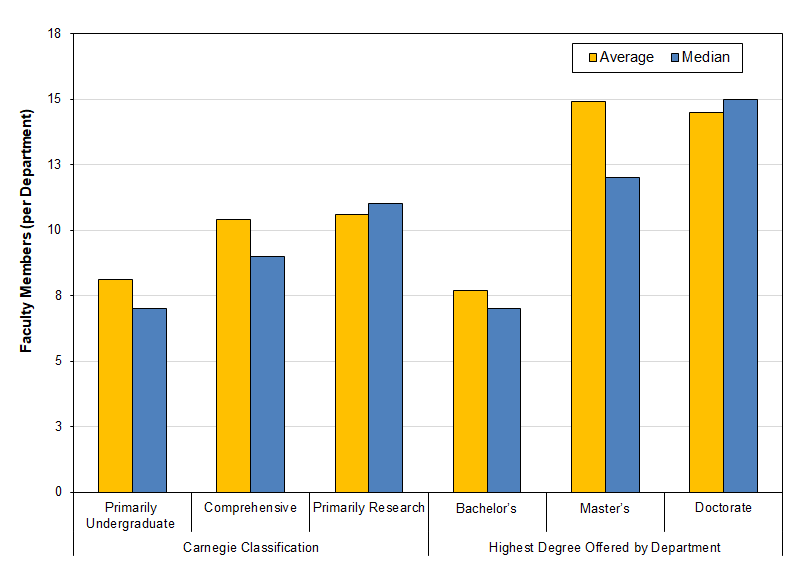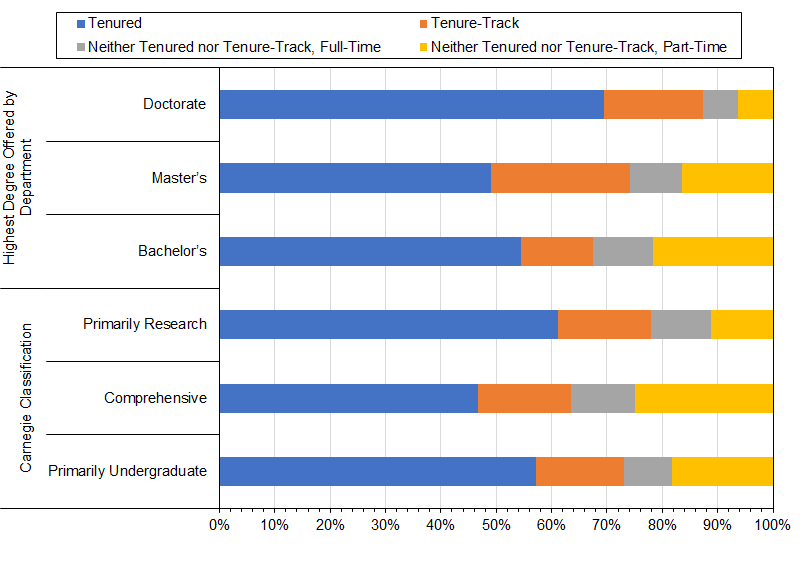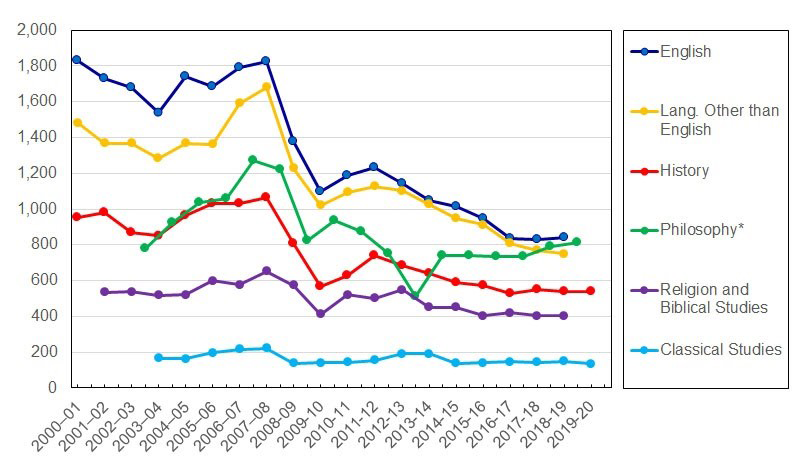Working Conditions for Graduate Students and Faculty in Religion Departments
This article is the second in a series that unpacks and contextualizes data on religion departments collected by the American Academy of Arts and Sciences Humanities Indicators project and written in collaboration between the American Academy and the AAR. Various data sources are noted along with numerous links to reports and indicators maintained by the Indicators. The first article in this series explored trends related to undergraduate and graduate enrollments and degree completions.
The recent Humanities Departmental Survey (HDS) contains a rich set of data on graduate student and faculty life. In light of many concerning trends, these data provide an empirical base for discussions about graduate student stipends, faculty research funding, and faculty employment and demographic trends. They also provide an opportunity to assess conditions in religious studies in the context of the humanities, show differences that result from heterogeneous departmental and institutional contexts, and offer some reflections on those differences. Where possible, HDS data are connected to other related and relevant data sources can that inform these conversations.
Graduate Students
The HDS includes questions related to graduate student financial support, often referred to as stipends. Within the humanities, religion departments reported the second-lowest percentage of full-time first-year doctoral students receiving full financial support for their studies (Table 16 HDS-3). Among the religion programs that completed the survey, there was little change across indicators over the past ten years, with only a slight decrease in the percentage of doctoral students receiving no financial support.
Approximately 540 teaching assistants were serving as instructors of record in religion departments nationwide in 2017, with an average of 5.3 per department. Among the various humanities disciplines, only 6 of the 17 humanities disciplines had a higher average per department (Table 17 HDS-3). The share of courses where graduate students were instructors of record was very near the average for all humanities departments, at just over 18% (combining values from Tables 11 and 18, HDS-3).
The Humanities Indicators project did not collect data on funding dollar amounts, but a number of religion and theology PhDs are represented in the self-reported stipend data from PhDStipends.com. Among those respondents were 60 observations from religion and directly adjacent fields. Analysis of that data in spring 2020 revealed that the average stipend for religion graduate students is just over $24,000 per year. The reported stipends differed quite a lot, however, ranging from $4,500 to $45,000 (the standard deviation of values was $7,757). Among those reported, 20 of the 21 highest-paid respondents were at private institutions and 11 of the 21 lowest paid were at public universities.
Faculty
Employment and Hiring
Religion departments had an average of 9.3 faculty members per department in Fall 2017, which ranks near the middle by number of faculty members among humanities departments (Table 1a. HDS-3). Unlike many of the other humanities disciplines, however, the average number of humanities departments is relatively consistent among the various department and institution types. At colleges classified as “primarily undergraduate” institutions (often liberal arts colleges) there was an average of 8 faculty members per religion department, while at research universities, there was an average of almost 11 (Fig. 1). In most other disciplines (classical studies, history, English, other modern languages, and philosophy) the average number of faculty at research universities was two or three times as large as the average at primarily undergraduate institutions.
Fig. 1: Average and Median Number of Faculty Members per Religion Department, by Carnegie Classification and Highest Degree Offered by Department, Fall 2017

Source: Humanities Indicators, The State of Religion Departments in Four-Year Colleges and Universities (2020), table REL1.
Although considerable attention in recent years has focused on the “adjunctification” of humanities departments, evidence from the Humanities Indicators (at least for four-year colleges and universities) does not seem to support a narrative of recent shifts in faculty employment type.
Approximately 71% of faculty employed in responding departments were either tenured or on the tenure track—modestly higher than the average for all humanities disciplines. For all humanities departments, the average was 53%. Meanwhile, approximately 10% of faculty were reported as full-time non-tenure track, and 19% were employed part-time.
Among religion departments that existed in 2012, the percentage of non-tenure-track faculty employed had not changed by a statistically significant amount by 2017, reflecting a more general pattern across all the surveyed humanities disciplines. Figure 2 shows the distribution of faculty employment type and number of faculty, including differences by institutional mission.
Fig. 2: Distribution of Faculty Members in Religion Departments by Employment Status, by Institution/Department Type, Fall 2017
Source: Humanities Indicators, The State of Religion Departments in Four-Year Colleges and Universities (2020), table REL2.
While there is little evidence that full-time faculty were being replaced by adjuncts in recent years, there is evidence that the hiring of new faculty in recent years has failed to keep pace with general growth in higher education. Approximately 33% of religion departments hired a new permanent faculty member for the start of the 2017–18 academic year—essentially unchanged from 2012–13—and 43% of the departments had a faculty member come up for tenure in the previous two years (Table 5, HDS-3).
Unfortunately, the job listings for new PhDs have been depressed for an extended period. Prior to 2017, the number of openings listed on the shared job’s board of the American Academy of Religion and the Society of Biblical literature fell by almost a third after the 2007–08, and has largely remained flat or declined further in the years since (Fig. 3).
Fig. 3: Number of Job Openings Posted with Scholarly Societies in the Humanities, 2001 to 2020

* Philosophy job listings reported by calendar year.
Source: Published reports from the scholarly societies for Classical Studies; History; Modern Languages; Philosophy; Religion and Biblical Studies.
As figure 2 shows, jobs in religion have reflected a broader trend in the humanities: a sharp drop during and immediately after the Great Recession, followed by a plateau or gradual decline over the subsequent decade. For religion, this represents a decline from 652 openings in 2007–08 to 403 in 2018–19. Data reflecting the pandemic are not yet available, but further declines are expected based on widespread job losses and hiring freezes across higher education.
Instruction, Evaluation, and Other Indicators
The survey also offers an array of other insights into the structure and culture of religion departments. For instance, while 98% of religion departments provided research support for their full-time tenured or tenure-track faculty members, 84% offered such support for full-time non-tenured or non-tenure-track faculty, and only 35% offered support for part-time faculty.
Tenured or tenure-track faculty were instructors of record for about 40% of all courses reported by religion departments, a figure slightly higher than the average across all disciplines. About a quarter of all reported courses are taught by full-time non-tenure-track faculty, and the remainder of courses are split almost evenly between graduate students and part-time non-tenure-track faculty—about 17% and 18% respectively.
Only two humanities disciplines reported full-time tenured or tenure-track professors as instructors for more than half of their courses. Religion departments, according to these figures, are slightly more reliant on full-time instructors than the average of all other humanities departments (combining values from Tables 11 and 18, HDS-3).
Another aspect of faculty life included in the survey offers insight into the considerations used in tenure decisions. Most religion departments rate publications and teaching as essential for tenure, and a majority of departments rate service to the department or institution as very important or important. Public humanities work was rated important to tenure by just a third of departments. There were very few statistically significant shifts over time, but there does appear to be evidence for increasing consideration of public-facing work. (Table REL15, HDS-3).
Among the various faculty service activities explored in the survey, several stand out as noteworthy for religion departments. Across three types of service to local communities, religion departments were less likely than the average humanities departments to report faculty, staff, or students engaged in the activity. Only 16% of religion departments reported any collaboration with K-12 teachers, compared to 43% across all disciplines. No humanities discipline had a lower percentage of such collaboration. Just 31% of religion departments reported collaboration with local humanities councils or community organizations, third lowest among all disciplines; and only 13% reported collaboration with local community colleges, exceeding only musicology, classics, American studies, and history of science departments (Table 27, HDS-3). This relative lack of engagement through service to local communities might be driven by any number of factors and conditions, but point to real opportunities for increasing the visibility of and impact of scholarship in the discipline.
Finally, the survey found that women comprised 35% of the faculty members in religion departments in Fall 2017, one of the lowest shares among disciplines included in the survey—and essentially unchanged from 2012 (Table 3, HDS-3). Religion departments remain male-dominated, even though the share of religion PhDs awarded to women has been growing unevenly since the 1990s (though the share of women earning doctoral degrees in the discipline generally remains below 40% each year).
Approximately 32% of all tenured faculty members in religion departments were women, compared to 46% of faculty members on the tenure track and 34% of those off the tenure track. (The nature of the HDS does not allow for the collection of data on race, ethnicity, sexuality, or non-binary gender identity of humanities faculty.)
The various data collected in the department can capture only a snapshot in time, but the past two surveys help to illustrate the impact of larger trends in religion departments and identify areas of both resilience and precarity. These data also provide insight on current faculty and graduate student working conditions. While the survey responses revealed that religion departments are very reliant on graduate students and non-tenure-track faculty, funding and other support for those instructors remain limited. As we stand on the cusp of the financial and institutional challenges sure to arise from the coronavirus pandemic, these indicators provide a baseline for informed advocacy about the working conditions of faculty and graduate students in religion departments.






